2006 CHEVROLET EXPRESS CARGO VAN heater
[x] Cancel search: heaterPage 279 of 406
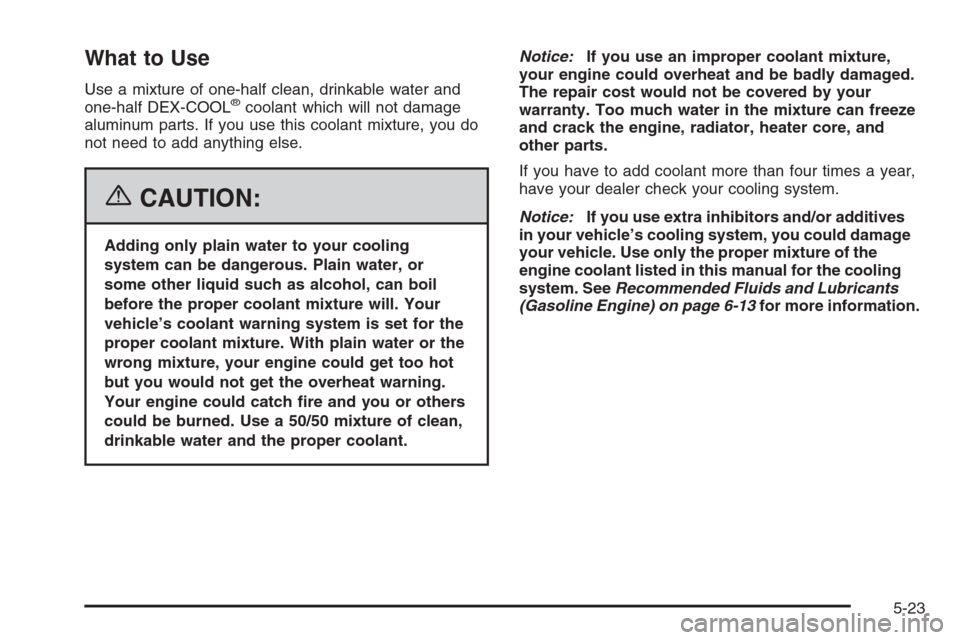
What to Use
Use a mixture of one-half clean, drinkable water and
one-half DEX-COOL®coolant which will not damage
aluminum parts. If you use this coolant mixture, you do
not need to add anything else.
{CAUTION:
Adding only plain water to your cooling
system can be dangerous. Plain water, or
some other liquid such as alcohol, can boil
before the proper coolant mixture will. Your
vehicle’s coolant warning system is set for the
proper coolant mixture. With plain water or the
wrong mixture, your engine could get too hot
but you would not get the overheat warning.
Your engine could catch �re and you or others
could be burned. Use a 50/50 mixture of clean,
drinkable water and the proper coolant.Notice:If you use an improper coolant mixture,
your engine could overheat and be badly damaged.
The repair cost would not be covered by your
warranty. Too much water in the mixture can freeze
and crack the engine, radiator, heater core, and
other parts.
If you have to add coolant more than four times a year,
have your dealer check your cooling system.
Notice:If you use extra inhibitors and/or additives
in your vehicle’s cooling system, you could damage
your vehicle. Use only the proper mixture of the
engine coolant listed in this manual for the cooling
system. SeeRecommended Fluids and Lubricants
(Gasoline Engine) on page 6-13for more information.
5-23
Page 282 of 406
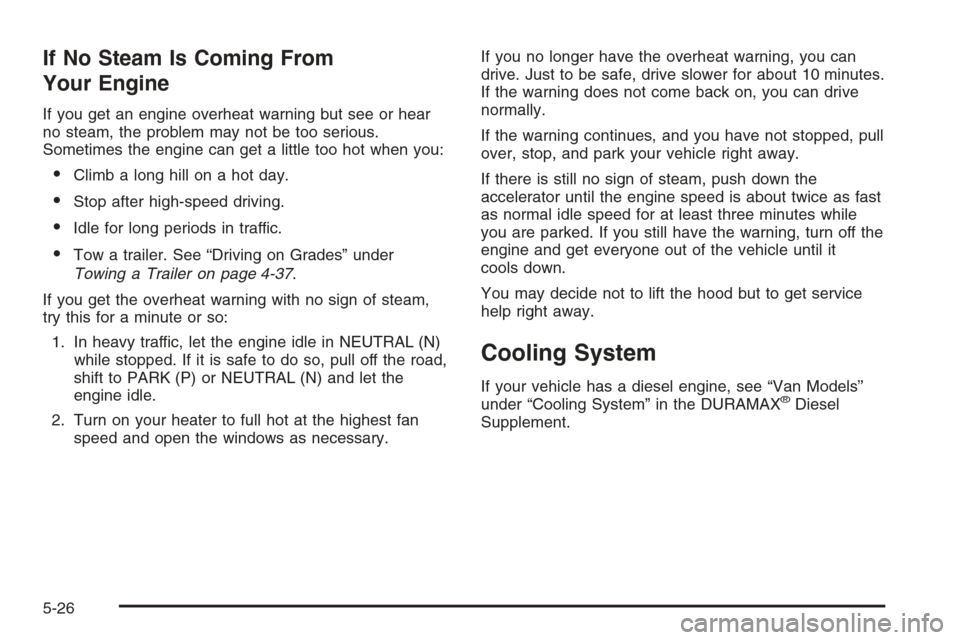
If No Steam Is Coming From
Your Engine
If you get an engine overheat warning but see or hear
no steam, the problem may not be too serious.
Sometimes the engine can get a little too hot when you:
•Climb a long hill on a hot day.
•Stop after high-speed driving.
•Idle for long periods in traffic.
•Tow a trailer. See “Driving on Grades” under
Towing a Trailer on page 4-37.
If you get the overheat warning with no sign of steam,
try this for a minute or so:
1. In heavy traffic, let the engine idle in NEUTRAL (N)
while stopped. If it is safe to do so, pull off the road,
shift to PARK (P) or NEUTRAL (N) and let the
engine idle.
2. Turn on your heater to full hot at the highest fan
speed and open the windows as necessary.If you no longer have the overheat warning, you can
drive. Just to be safe, drive slower for about 10 minutes.
If the warning does not come back on, you can drive
normally.
If the warning continues, and you have not stopped, pull
over, stop, and park your vehicle right away.
If there is still no sign of steam, push down the
accelerator until the engine speed is about twice as fast
as normal idle speed for at least three minutes while
you are parked. If you still have the warning, turn off the
engine and get everyone out of the vehicle until it
cools down.
You may decide not to lift the hood but to get service
help right away.
Cooling System
If your vehicle has a diesel engine, see “Van Models”
under “Cooling System” in the DURAMAX®Diesel
Supplement.
5-26
Page 283 of 406
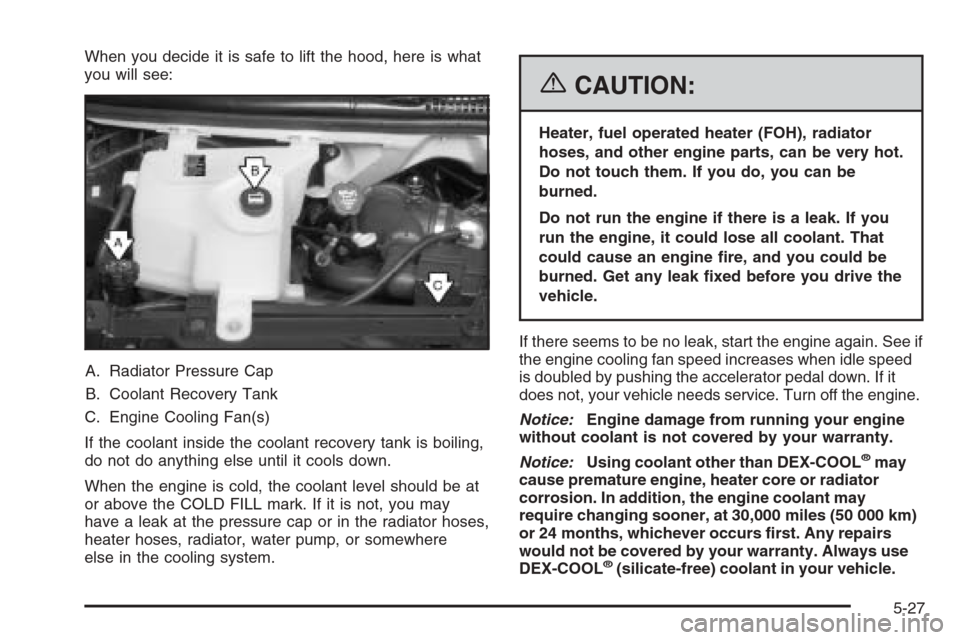
When you decide it is safe to lift the hood, here is what
you will see:
A. Radiator Pressure Cap
B. Coolant Recovery Tank
C. Engine Cooling Fan(s)
If the coolant inside the coolant recovery tank is boiling,
do not do anything else until it cools down.
When the engine is cold, the coolant level should be at
or above the COLD FILL mark. If it is not, you may
have a leak at the pressure cap or in the radiator hoses,
heater hoses, radiator, water pump, or somewhere
else in the cooling system.
{CAUTION:
Heater, fuel operated heater (FOH), radiator
hoses, and other engine parts, can be very hot.
Do not touch them. If you do, you can be
burned.
Do not run the engine if there is a leak. If you
run the engine, it could lose all coolant. That
could cause an engine �re, and you could be
burned. Get any leak �xed before you drive the
vehicle.
If there seems to be no leak, start the engine again. See if
the engine cooling fan speed increases when idle speed
is doubled by pushing the accelerator pedal down. If it
does not, your vehicle needs service. Turn off the engine.
Notice:Engine damage from running your engine
without coolant is not covered by your warranty.
Notice:Using coolant other than DEX-COOL
®may
cause premature engine, heater core or radiator
corrosion. In addition, the engine coolant may
require changing sooner, at 30,000 miles (50 000 km)
or 24 months, whichever occurs �rst. Any repairs
would not be covered by your warranty. Always use
DEX-COOL
®(silicate-free) coolant in your vehicle.
5-27
Page 285 of 406
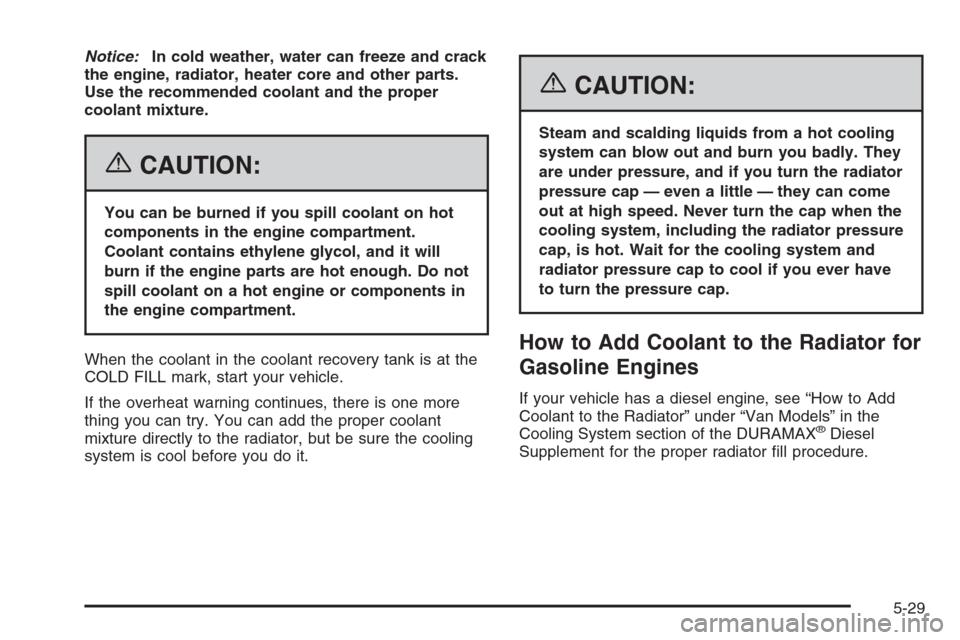
Notice:In cold weather, water can freeze and crack
the engine, radiator, heater core and other parts.
Use the recommended coolant and the proper
coolant mixture.
{CAUTION:
You can be burned if you spill coolant on hot
components in the engine compartment.
Coolant contains ethylene glycol, and it will
burn if the engine parts are hot enough. Do not
spill coolant on a hot engine or components in
the engine compartment.
When the coolant in the coolant recovery tank is at the
COLD FILL mark, start your vehicle.
If the overheat warning continues, there is one more
thing you can try. You can add the proper coolant
mixture directly to the radiator, but be sure the cooling
system is cool before you do it.
{CAUTION:
Steam and scalding liquids from a hot cooling
system can blow out and burn you badly. They
are under pressure, and if you turn the radiator
pressure cap — even a little — they can come
out at high speed. Never turn the cap when the
cooling system, including the radiator pressure
cap, is hot. Wait for the cooling system and
radiator pressure cap to cool if you ever have
to turn the pressure cap.
How to Add Coolant to the Radiator for
Gasoline Engines
If your vehicle has a diesel engine, see “How to Add
Coolant to the Radiator” under “Van Models” in the
Cooling System section of the DURAMAX
®Diesel
Supplement for the proper radiator fill procedure.
5-29
Page 291 of 406
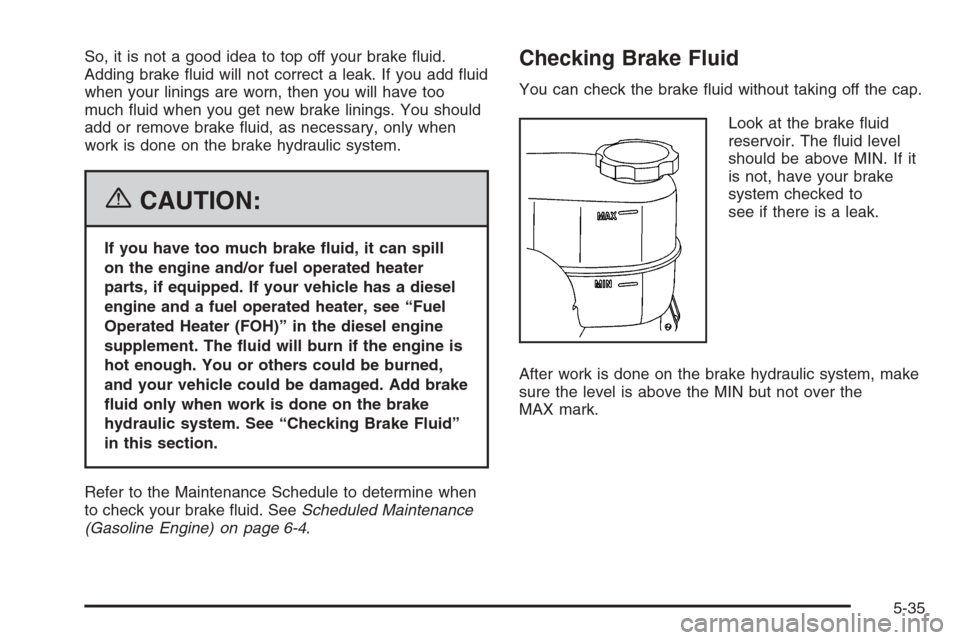
So, it is not a good idea to top off your brake fluid.
Adding brake fluid will not correct a leak. If you add fluid
when your linings are worn, then you will have too
much fluid when you get new brake linings. You should
add or remove brake fluid, as necessary, only when
work is done on the brake hydraulic system.
{CAUTION:
If you have too much brake �uid, it can spill
on the engine and/or fuel operated heater
parts, if equipped. If your vehicle has a diesel
engine and a fuel operated heater, see “Fuel
Operated Heater (FOH)” in the diesel engine
supplement. The �uid will burn if the engine is
hot enough. You or others could be burned,
and your vehicle could be damaged. Add brake
�uid only when work is done on the brake
hydraulic system. See “Checking Brake Fluid”
in this section.
Refer to the Maintenance Schedule to determine when
to check your brake fluid. SeeScheduled Maintenance
(Gasoline Engine) on page 6-4.
Checking Brake Fluid
You can check the brake fluid without taking off the cap.
Look at the brake fluid
reservoir. The fluid level
should be above MIN. If it
is not, have your brake
system checked to
see if there is a leak.
After work is done on the brake hydraulic system, make
sure the level is above the MIN but not over the
MAX mark.
5-35
Page 353 of 406

Fuse Usage
6 Ignition 0
7 Stoplamp
8 Rear Defogger/Heated Mirror
9Right Daytime Running Lamp/
Turn Signal
10Left Daytime Running Lamp/
Turn Signal
11 Truck Body Control Module 4
12 Fuel Pump
13 Trailer
14 Hazard Flashers
15 Horn
16 Truck Body Control Module 3
17 Trailer Stop/Turn Signal
18 Truck Body Control Module 2
19 Truck Body Control Module
20 Remote Function Actuator
21 Engine 2 (Gas), Spare (Diesel)
22 Ignition E
23 Engine 1
24 Truck Body Control Module Ignition 1
25 Spare (Gas), Fuel Heater (Diesel)
26 Inside Rearview Mirror
27 CrankcaseFuse Usage
28Brake Transmission Shift Interlock
System
29 Auxiliary Power Outlets
30 Cigarette Lighter
31 Instrument Panel Cluster
32 Air Conditioning
33Spare (Gas), Engine Control
Module (Diesel)
34Canister Vent Solenoid (Gas),
Rear Fog Lamps (Diesel)
35 Spare
36Brake Transmission Shift Interlock,
Vehicle Back-Up
37 Airbag
38Powertrain Control Module Ignition 1
(Gas), Engine Control Module,
Transmission Control Module, Glow
Plug Control Module Ignition 1
(Diesel)
39Oxygen Sensor B (Gas),
Spare (Diesel)
40 Oxygen Sensor A
41 Windshield Wipers
42 Right Headlamp - Low Beam
43 Left Headlamp - Low Beam
44 Left Headlamp - High Beam
5-97
Page 395 of 406
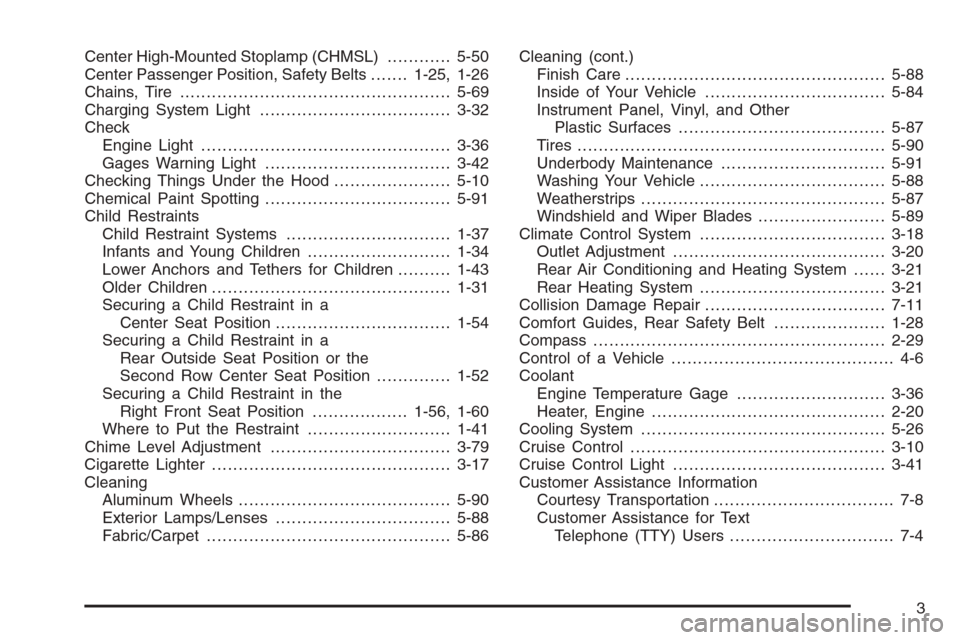
Center High-Mounted Stoplamp (CHMSL)............5-50
Center Passenger Position, Safety Belts.......1-25, 1-26
Chains, Tire...................................................5-69
Charging System Light....................................3-32
Check
Engine Light...............................................3-36
Gages Warning Light...................................3-42
Checking Things Under the Hood......................5-10
Chemical Paint Spotting...................................5-91
Child Restraints
Child Restraint Systems...............................1-37
Infants and Young Children...........................1-34
Lower Anchors and Tethers for Children..........1-43
Older Children.............................................1-31
Securing a Child Restraint in a
Center Seat Position.................................1-54
Securing a Child Restraint in a
Rear Outside Seat Position or the
Second Row Center Seat Position..............1-52
Securing a Child Restraint in the
Right Front Seat Position..................1-56, 1-60
Where to Put the Restraint...........................1-41
Chime Level Adjustment..................................3-79
Cigarette Lighter.............................................3-17
Cleaning
Aluminum Wheels........................................5-90
Exterior Lamps/Lenses.................................5-88
Fabric/Carpet..............................................5-86Cleaning (cont.)
Finish Care.................................................5-88
Inside of Your Vehicle..................................5-84
Instrument Panel, Vinyl, and Other
Plastic Surfaces.......................................5-87
Tires..........................................................5-90
Underbody Maintenance...............................5-91
Washing Your Vehicle...................................5-88
Weatherstrips..............................................5-87
Windshield and Wiper Blades........................5-89
Climate Control System...................................3-18
Outlet Adjustment........................................3-20
Rear Air Conditioning and Heating System......3-21
Rear Heating System...................................3-21
Collision Damage Repair..................................7-11
Comfort Guides, Rear Safety Belt.....................1-28
Compass.......................................................2-29
Control of a Vehicle.......................................... 4-6
Coolant
Engine Temperature Gage............................3-36
Heater, Engine............................................2-20
Cooling System..............................................5-26
Cruise Control................................................3-10
Cruise Control Light........................................3-41
Customer Assistance Information
Courtesy Transportation.................................. 7-8
Customer Assistance for Text
Telephone (TTY) Users............................... 7-4
3
Page 397 of 406
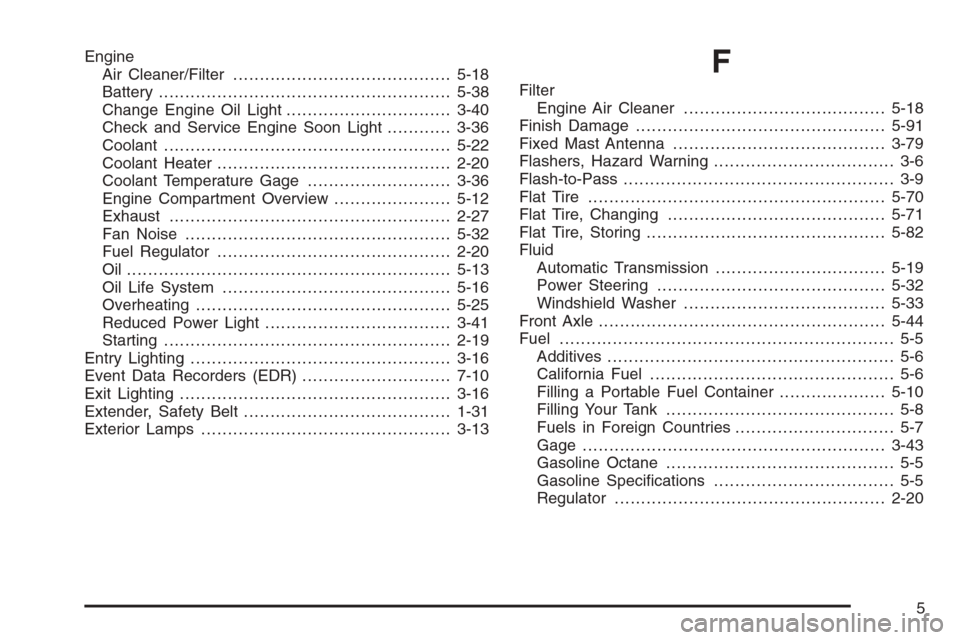
Engine
Air Cleaner/Filter.........................................5-18
Battery.......................................................5-38
Change Engine Oil Light...............................3-40
Check and Service Engine Soon Light............3-36
Coolant......................................................5-22
Coolant Heater............................................2-20
Coolant Temperature Gage...........................3-36
Engine Compartment Overview......................5-12
Exhaust.....................................................2-27
Fan Noise..................................................5-32
Fuel Regulator............................................2-20
Oil .............................................................5-13
Oil Life System...........................................5-16
Overheating................................................5-25
Reduced Power Light...................................3-41
Starting......................................................2-19
Entry Lighting.................................................3-16
Event Data Recorders (EDR)............................7-10
Exit Lighting...................................................3-16
Extender, Safety Belt.......................................1-31
Exterior Lamps...............................................3-13F
Filter
Engine Air Cleaner......................................5-18
Finish Damage...............................................5-91
Fixed Mast Antenna........................................3-79
Flashers, Hazard Warning.................................. 3-6
Flash-to-Pass................................................... 3-9
Flat Tire........................................................5-70
Flat Tire, Changing.........................................5-71
Flat Tire, Storing.............................................5-82
Fluid
Automatic Transmission................................5-19
Power Steering...........................................5-32
Windshield Washer......................................5-33
Front Axle......................................................5-44
Fuel............................................................... 5-5
Additives...................................................... 5-6
California Fuel.............................................. 5-6
Filling a Portable Fuel Container....................5-10
Filling Your Tank........................................... 5-8
Fuels in Foreign Countries.............................. 5-7
Gage .........................................................3-43
Gasoline Octane........................................... 5-5
Gasoline Specifications.................................. 5-5
Regulator...................................................2-20
5